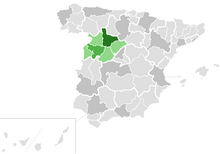Loading AI tools
Roman Catholic diocese in Spain From Wikipedia, the free encyclopedia
The Diocese of Salamanca (Latin: Dioecesis Salmantina) is a Latin diocese of the Catholic Church located in the city of Salamanca in the ecclesiastical province of Valladolid in Spain.[1][2]
Diocese of Salamanca Dioecesis Salmantina Diócesis de Salamanca | |
|---|---|
 | |
| Location | |
| Country | Spain |
| Ecclesiastical province | Valladolid |
| Metropolitan | Valladolid |
| Statistics | |
| Area | 7,876 km2 (3,041 sq mi) |
| Population - Total - Catholics | (as of 2010) 302,200 296,000 (97.9%) |
| Information | |
| Rite | Latin Rite |
| Cathedral | New Cathedral Basilica of Our Lady of the Siege in Salamanca |
| Co-cathedral | Old Cathedral of Our Lady in Salamanca |
| Current leadership | |
| Pope | Francis |
| Bishop | José Luis Retana Gozalo |
| Metropolitan Archbishop | Luis Javier Argüello García |
| Bishops emeritus | Carlos López Hernández |
| Map | |
 | |
| Website | |
| Website of the Diocese | |
The See of Salamanca is of unknown origin. St. Secundus is said to have founded the Diocese of Avila. Signatures of bishops of Salamanca are found in the Councils of Toledo; in the third council is that of Eleutherius; at the coronation of King Gondemar, that of Teveristus; in the fourth and sixth of Hiccila; in the seventh, eighth and tenth, of Egeretus; in the Provincial Council of Mérida (metropolis of Salamanca) the signature of Justus;in the twelfth of Toledo that of Providentius; in the thirteenth, fifteenth, and sixteenth, of Holemund, probably contemporaneous with the Muslim invasion.
Alfonso I the Catholic pushed his conquests as far as Salamanca, and Ordoño I of Asturias captured the city, but its bishops continued to reside in Asturias, where the Church of San Julian, outside the walls of Oviedo, was assigned to them. Bishop Quindulfus (802) signed a royal deed of gift. Ramiro II of León, who defeated the Muslim forces at Simancas, began to repopulate Salamanca. In 1102 the king's son-in-law Raymond, Count of Burgundy, and his wife Urraca of Castile, gave the churches of the city to Don Jerónimo, the count's master, and built the Cathedral of S. Maria. The celebrated bishop, comrade of the Cid Campeador, died in 1120 and was interred in the newly built basilica, to which he left the "Christ of the Battles" (Cristo de las Batallas).
Later bishops were:
From his period date the university of Salamanca and the most ancient and famous convents of Dominicans, Franciscans, and Clarisses. In October, 1310, the see being vacant, fifteen prelates of the ancient Province of Lusitania, presided over by the Archbishop of Santiago, assembled in the cathedral of Salamanca to try the case of the Knights Templar, and found them innocent in Spain of all the atrocities with which they were charged.
Bishop Juan Lucero accompanied King Alfonso XI to the conquest of Algeciras. Later on he became subservient to the caprices of Pedro I the Cruel and annulled (1354) his marriage with Blanche of Bourbon in order to unite him with Juana de Castro. Lucero's successor, Alsonso Barrasa, on the contrary, supported Henry of Trastamare against Pedro. In May, 1382, a council was held at Salamanca to take action in the matter of the schism of Avignon, and Castile decided in favour of the antipope. In another council (1410) Salamanca again recognized Peter de Luna (Benedict XIII) as pope. At this time Vincent Ferrer laboured to convert the Jews of Salamanca; from 1460 to 1478 John of Sahagun preached in the diocese.[3][circular reference]
Seamless Wikipedia browsing. On steroids.
Every time you click a link to Wikipedia, Wiktionary or Wikiquote in your browser's search results, it will show the modern Wikiwand interface.
Wikiwand extension is a five stars, simple, with minimum permission required to keep your browsing private, safe and transparent.